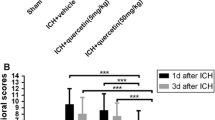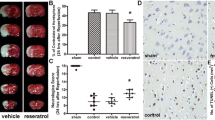Abstract
Background
Blood–brain barrier (BBB) disruption mediated by matrix metalloproteinase (MMPs) activation is a critical event during cerebral ischemia. The inhibition of MMP might be a potential approach to protect against secondary injury. The present study was designed to determine the effects of quercetin on BBB disruption and MMP activity, in a focal ischemia model induced by photothrombosis, in rats.
Methods
Adult male Sprague–Dawley rats received focal ischemia by photothrombosis. The injured animals were divided into two groups: one group received 25 μmol/kg of quercetin intraperitoneally, starting 1 h after injury with continued treatment at 12-h intervals for 3 days, while animals in the control group received weight-adjusted doses of a saline vehicle. The effects of quercetin on BBB disruption, brain edema, MMP activities, and neurological deficits were determined.
Findings
Quercetin treatment markedly reduced ischemia-induced up-regulation of MMP-9 at 24 and 48 h after ischemic injury. No significant change in MMP-2 activity was observed throughout the experimental period. Post-ischemic increase in BBB permeability and brain edema were significantly reduced in the quercetin-treated group compared to the vehicle-treated ischemia control. Quercetin treatment significantly improved the functional outcomes assessed by the accelerating rotarod test.
Conclusions
The results of this study demonstrated that quercetin attenuated BBB disruption during focal ischemia through inhibitory effects on MMP-9 activity. These results suggest that quercetin might have a potential role in the protection against neuronal injury in patients with focal ischemic stroke.





Similar content being viewed by others
References
Asahi M, Asahi K, Jung JC, del Zoppo GJ, Fini ME, Lo EH (2000) Role for matrix metalloproteinase 9 after focal cerebral ischemia: effects of gene knockout and enzyme inhibition with BB-94. J Cereb Blood Flow Metab 20:1681–1689
Asahi M, Sumii T, Fini ME, Itohara S, Lo EH (2001) Matrix metalloproteinase 2 gene knockout has no effect on acute brain injury after focal ischemia. Neuroreport 12:3003–3007
Chen TY, Lee MY, Chen HY, Kuo YL, Lin SC, Wu TS, Lee EJ (2006) Melatonin attenuates the postischemic increase in blood–brain barrier permeability and decreases hemorrhagic transformation of tissue-plasminogen activator therapy following ischemic stroke in mice. J Pineal Res 40:242–250
Cho JY, Kim IS, Jang YH, Kim AR, Lee SR (2006) Protective effect of quercetin, a natural flavonoid against neuronal damage after transient global cerebral ischemia. Neurosci Lett 404:330–335
Clark AW, Krekoski CA, Bou SS, Chapman KR, Edwards DR (1997) Increased gelatinase A (MMP-2) and gelatinase B (MMP-9) activities in human brain after focal ischemia. Neurosci Lett 238:53–56
Dietrich WD, Busto R, Watson BD, Scheinberg P, Ginsberg MD (1987) Photochemically induced cerebral infarction. II. Edema and blood–brain barrier disruption. Acta Neuropathol 72:326–334
Dietrich WD, Watson BD, Busto R, Ginsberg MD, Bethea JR (1987) Photochemically induced cerebral infarction. I. Early microvascular alterations. Acta Neuropathol 72:315–325
Fujimura M, Gasche Y, Morita-Fujimura Y, Massengale J, Kawase M, Chan PH (1999) Early appearance of activated matrix metalloproteinase-9 and blood–brain barrier disruption in mice after focal cerebral ischemia and reperfusion. Brain Res 842:92–100
Gasche Y, Copin JC, Sugawara T, Fujimura M, Chan PH (2001) Matrix metalloproteinase inhibition prevents oxidative stress-associated blood–brain barrier disruption after transient focal cerebral ischemia. J Cereb Blood Flow Metab 21:1393–1400
Gasche Y, Fujimura M, Morita-Fujimura Y, Copin JC, Kawase M, Massengale J, Chan PH (1999) Early appearance of activated matrix metalloproteinase-9 after focal cerebral ischemia in mice: a possible role in blood–brain barrier dysfunction. J Cereb Blood Flow Metab 19:1020–1028
Gidday JM, Gasche YG, Copin JC, Shah AR, Perez RS, Shapiro SD, Chan PH, Park TS (2005) Leukocyte-derived matrix metalloproteinase-9 mediates blood–brain barrier breakdown and is proinflammatory after transient focal cerebral ischemia. Am J Physiol Heart Circ Physiol 289:H558–H568
Hertog MG, Hollman PC (1996) Potential health effects of the dietary flavonol quercetin. Eur J Clin Nutr 50:63–71
Jian Liu K, Rosenberg GA (2005) Matrix metalloproteinases and free radicals in cerebral ischemia. Free Radic Biol Med 39:71–80
Justicia C, Panes J, Sole S, Cervera A, Deulofeu R, Chamorro A, Planas AM (2003) Neutrophil infiltration increases matrix metalloproteinase-9 in the ischemic brain after occlusion/reperfusion of the middle cerebral artery in rats. J Cereb Blood Flow Metab 23:1430–1440
Kim GW, Gasche Y, Grzeschik S, Copin JC, Maier CM, Chan PH (2003) Neurodegeneration in striatum induced by the mitochondrial toxin 3-nitropropionic acid: role of matrix metalloproteinase-9 in early blood–brain barrier disruption? J Neurosci 23:8733–8742
Lee JE, Yoon YJ, Moseley ME, Yenari MA (2005) Reduction in levels of matrix metalloproteinases and increased expression of tissue inhibitor of metalloproteinase-2 in response to mild hypothermia therapy in experimental stroke. J Neurosurg 103:289–297
Lee SR, Tsuji K, Lo EH (2004) Role of matrix metalloproteinases in delayed neuronal damage after transient global cerebral ischemia. J Neurosci 24:671–678
Magnoni S, Baker A, George SJ, Duncan WC, Kerr LE, McCulloch J, Horsburgh K (2004) Differential alterations in the expression and activity of matrix metalloproteinases 2 and 9 after transient cerebral ischemia in mice. Neurobiol Dis 17:188–197
Montaner J, Alvarez-Sabin J, Molina CA, Angles A, Abilleira S, Arenillas J, Monasterio J (2001) Matrix metalloproteinase expression is related to hemorrhagic transformation after cardioembolic stroke. Stroke 32:2762–2767
Moon SK, Cho GO, Jung SY, Gal SW, Kwon TK, Lee YC, Madamanchi NR, Kim CH (2003) Quercetin exerts multiple inhibitory effects on vascular smooth muscle cells: role of ERK1/2, cell-cycle regulation, and matrix metalloproteinase-9. Biochem Biophys Res Commun 301:1069–1078
Piao MS, Lee JK, Park CS, Ryu HS, Kim SH, Kim HS (2009) Early activation of matrix metalloproteinase-9 is associated with blood–brain barrier disruption after photothrombotic cerebral ischemia in rats. Acta Neurochir (Wien) 151:1649–1653
Romanic AM, White RF, Arleth AJ, Ohlstein EH, Barone FC (1998) Matrix metalloproteinase expression increases after cerebral focal ischemia in rats: inhibition of matrix metalloproteinase-9 reduces infarct size. Stroke 29:1020–1030
Rosell A, Cuadrado E, Ortega-Aznar A, Hernandez-Guillamon M, Lo EH, Montaner J (2008) MMP-9-positive neutrophil infiltration is associated to blood–brain barrier breakdown and basal lamina type IV collagen degradation during hemorrhagic transformation after human ischemic stroke. Stroke 39:1121–1126
Rosenberg GA, Estrada EY, Dencoff JE (1998) Matrix metalloproteinases and TIMPs are associated with blood–brain barrier opening after reperfusion in rat brain. Stroke 29:2189–2195
Schroeter M, Jander S, Stoll G (2002) Non-invasive induction of focal cerebral ischemia in mice by photothrombosis of cortical microvessels: characterization of inflammatory responses. J Neurosci Methods 117:43–49
Schultke E, Kamencic H, Zhao M, Tian GF, Baker AJ, Griebel RW, Juurlink BH (2005) Neuroprotection following fluid percussion brain trauma: a pilot study using quercetin. J Neurotrauma 22:1475–1484
Takizawa S, Fukuyama N, Hirabayashi H, Kohara S, Kazahari S, Shinohara Y, Nakazawa H (2003) Quercetin, a natural flavonoid, attenuates vacuolar formation in the optic tract in rat chronic cerebral hypoperfusion model. Brain Res 980:156–160
Wang X, Jung J, Asahi M, Chwang W, Russo L, Moskowitz MA, Dixon CE, Fini ME, Lo EH (2000) Effects of matrix metalloproteinase-9 gene knock-out on morphological and motor outcomes after traumatic brain injury. J Neurosci 20:7037–7042
Youdim KA, Qaiser MZ, Begley DJ, Rice-Evans CA, Abbott NJ (2004) Flavonoid permeability across an in situ model of the blood–brain barrier. Free Radic Biol Med 36:592–604
Zhao CS, Puurunen K, Schallert T, Sivenius J, Jolkkonen J (2005) Behavioral and histological effects of chronic antipsychotic and antidepressant drug treatment in aged rats with focal ischemic brain injury. Behav Brain Res 158:211–220
Zhao CS, Puurunen K, Schallert T, Sivenius J, Jolkkonen J (2005) Behavioral effects of photothrombotic ischemic cortical injury in aged rats treated with the sedative-hypnotic GABAergic drug zopiclone. Behav Brain Res 160:260–266
Zou LY, Cheung RT, Liu S, Li G, Huang L (2006) Melatonin reduces infarction volume in a photothrombotic stroke model in the wild-type but not cyclooxygenase-1-gene knockout mice. J Pineal Res 41:150–156
Acknowledgments
This work was supported by the Korea Research Foundation Grant funded by the Korean Government (MOEHRD, Basic Research Promotion Fund) (KRF-2007-331-H00007). The authors have no personal financial or institutional interest in any of the drugs, materials, or devices described in this article.
Conflicts of interest
None.
Author information
Authors and Affiliations
Corresponding author
Additional information
Comment
The authors have examined the effects of antioxidant therapy on the generation of blood–brain barrier (BBB) disruptions in focal ischemia. This topic has been a promising one, with many animal models vaunting the protective effects of antioxidants in reducing neural damage following ischemia, even hours after the initial insult [1].
The manuscript provides convincing evidence of Quercetin’s ability to reduce permeability across the BBB post-ischemia and so reduce ischemia-induced cerebral edema. Their data demonstrating reductions in MMP9 post-quercetin administration also provide a potential mechanism for the compound’s ability to reduce ischemia damage to the BBB.
The topic of antioxidants in stroke has been a tantalizing and frustrating one, but these data build evidence for a novel drug that may be both protective and therapeutic for the secondary damage caused by stroke.
[1] Ginsberg MD (2008) Neuroprotection for ischemic stroke: past, present, and future. Neuropharmacology 55:363–89
Markus Bookland, M.D.
Christopher M. Loftus, M.D., F.A.C.S.
Philadelphia, USA
Rights and permissions
About this article
Cite this article
Lee, JK., Kwak, HJ., Piao, MS. et al. Quercetin reduces the elevated matrix metalloproteinases-9 level and improves functional outcome after cerebral focal ischemia in rats. Acta Neurochir 153, 1321–1329 (2011). https://doi.org/10.1007/s00701-010-0889-x
Received:
Accepted:
Published:
Issue Date:
DOI: https://doi.org/10.1007/s00701-010-0889-x




